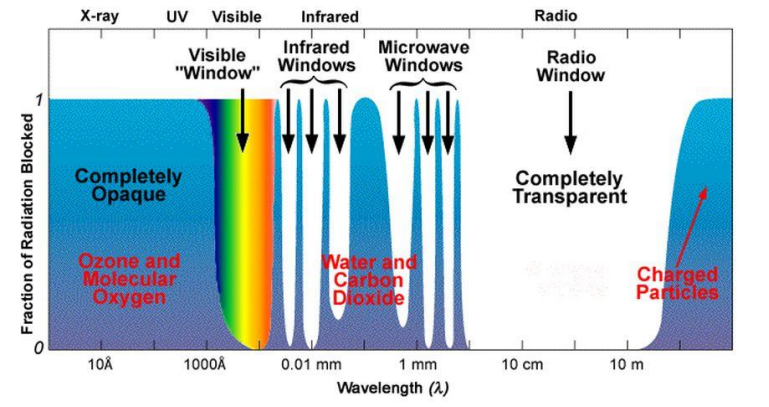Transparency of the Earth’s atmosphere (atmospheric windows)
Our Sun is a source of emission in all parts of the electromagnetic spectrum and our atmosphere is constantly bombarded by its radiation. The gamma-rays, X-rays, and short UV-rays are ionising emissions, i.e. their energy is sufficiently high to break-off electrons from the atoms and molecules. The exposure to such radiation destroys the cells of organic matter. The atmosphere protects us from this dangerous to life high-energy radiation from the Sun and the Galaxy.
Not all of the spectral ranges can pass through the atmosphere and for their study we need to use space telescopes. The atmosphere, which protects the Earth and makes it habitable is also an obstacle for the exploration of sources of high-energy emission in the Universe. Sensitive to the different ranges of the EM spectrum are detectors with significantly different properties. This is why the astronomers have to use numerous different detectors and telescopes, both ground-based and in space.
The opacity of the atmosphere in regard to the other spectral ranges is due to absorption and scattering of the emission from the atoms and molecules of different gases (mainly water, CO2 and ozone), and also by reflection of radio waves from the electrons in the ionosphere (see the red notations on Figure 3).

Figure 3. Atmospheric “windows” In blue is shown the part of the radiation that is blocked from the atmosphere and does not reach the surface. The X-rays are completely blocked, only a small part of the UV can get through, optical (visible) light is transmitted in full, and the infrared and microwave radiation is again partially transmitted, while the biggest part of the radio window is completely transparent. In red are listed the main “culprits” for the atmospheric opacity (the blocking of the radiation) - ozone and molecular oxygen in the X-ray and UV ranges, charged particles at the longest radio waves.


